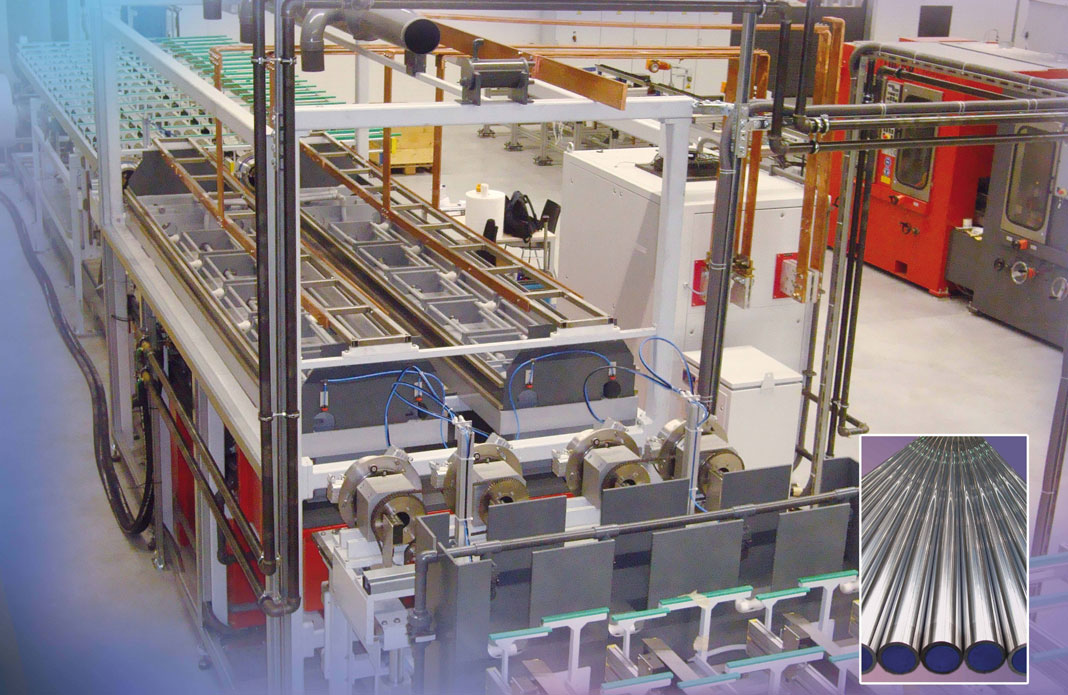
Innovative through feed chrome plating
Developing the chrome plating technology and designing a process reliable chrome plating machine was an important step for Loeser on the road to becoming a supplier of complete systems in the market of surface optimization of bars and pipes.
Through type chrome plating is used to seal with a galvanic chrome layer on the surface of parts that are produced for mechanically demanding applications. Many mechanical parts, like cylinders, mechanical guides or press punches can be produced simply and economically. Chromium plating is an electrochemical process, used to seal the surface of a metal with a coat of chrome. For mechanical use or respectively for protection, the thickness of the chromium coating ranges between a few hundredths and a few tenths of a millimetres.
In the past the work pieces were dipped into a tank filled with chromium acid. The tank was equipped with lead anodes, attached to the positive pole of a rectifier. The work piece had to be attached to the negative pole of the rectifier. However this procedure poses several major problems:
- While the bars leave the chromium bath, some of the chromium acid liquid can drop to the floor;
- Large tanks are filled with many thousand litres of chromium acid;
- The guidelines for appropriate handling of chromium acid are kept very strictly all over the world;
- Strict official approval proceedings are required.
- The reduction of the amount of chrome bath solution in regard to reducing pollution is an absolute necessity;
- The thickness of the chromium layer is hard to control.
- The position of the anodes is radially asymmetrical with respect to the bars. Therefore the chromium layer is not consistent.
- Due to the distribution of the lines of force the chromium layer increases in areas that experience a stronger flow of the electric current.
- The procedure generates a product of lesser quality that consumes a large amount of chromium and entails environmental damage
Loeser developed a through type chrome plating machine, which solves these problems elegantly.
The advantages of the through type chrome plating system developed by Loeser must be regarded as a breakthrough in the implementation of this technology. The work pieces are coated homogeneously and completely and there is no waste. The drive system is dimensioned and designed precisely so, that the electrical contacts rest securely during the transport process and the infeed parameters can be optimally adjusted.
The chromium layer is homogeneous and the quality of the plating is very high. Additionally chromium consumption is low and the product quality, after the system parameters have been set, is first rate and reproducible. Production costs are optimized and environmental impact is low. The process parameters can be saved in the control system and uploaded from memory as required. The machine is designed in such a way that several work pieces of the same diameter can be plated in parallel by one through type plating system.
The system can be designed for different diameter ranges.
Standard machines work within the diameter ranges of 20mm to 70mm and 70mm to 150mm.Usually the thickness of the chromium layer ranges between 10 and 50 micrometers.
The layer has to contain miniscule fissures in order to prevent the chromium layer to break. The chromium layer is of a harder consistency than the steel it surrounds. Without the fissures the layer can break open due to climate conditions or the elasticity of the steel core. Large cracks allow oxygen to reach the steel core which causes corrosion there. Micro fissure offer the best protection against inadmissibly large cracks. Before plating the surface of the work piece must be finely polished. The quality of the plating depends largely on the surface quality of the starting material. After plating the surface must be polished to reach a high surface quality and to relieve the tension in the chromium layer. Additionally the chromium layer can be sealed with wax.
